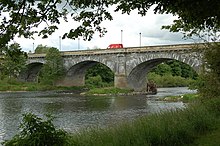Kelso Bridge
| Kelso Bridge | |
|---|---|
 |
|
| Coordinates | 55°35′43″N 2°26′01″W / 55.595352°N 2.433480°WCoordinates: 55°35′43″N 2°26′01″W / 55.595352°N 2.433480°W |
| Crosses | River Tweed |
| Heritage status | Category A listed |
| Characteristics | |
| Material | Stone |
| Longest span | 72 feet (22 m) |
| No. of spans | 6 |
| History | |
| Designer | John Rennie the Elder |
| Constructed by | Murray & Lees |
| Construction begin | 1800 |
| Construction end | 1803 |
The Kelso Bridge or Rennie's Bridge is a bridge across the River Tweed at Kelso, in the Scottish Borders.
The first bridge at the site was opened in 1754, funded by public subscription. It had six arches, and replaced a ferry which was dangerous during times of bad weather and limited the volume of traffic that could pass through the town. An arch collapsed in 1756, killing 6 people. The bridge was repaired, but a storm on 25 October 1797 caused damage to the foundations of the centre arches, and the weakened structure collapsed into the river the following day.
John Rennie engineered the replacement bridge, which was built between 1800 and 1803, but he had been considering the design since 1798. It was his first major road bridge, and he gave exacting instructions for its construction, advising the trustees to build deep foundations by day labour instead of contract. The piers were sunk into the bedrock to a depth of 7 feet (2.1 m) using cofferdams, this level being around 15 feet (4.6 m) below low water. The cofferdams were kept dry by a pump driven by a water wheel on the south bank of the river.
The bridge was built by a partnership between John Murray of Edinburgh and Robert Lees of East Lothian. It is situated about 50 yards (46 m) downstream of the site of the old bridge.
The replacement bridge cost GB£12,876, part of which was funded by a government loan. This money was repaid by collecting tolls, which were meant to be collected only until the cost of construction had been repaid, but in 1825 the right to collect tolls was let at GB£900 per year, making the bridge extremely profitable. The collection of tolls continued until 1854, when there were riots protesting the failure of the trust that ran the bridge to publish accounts. Soldiers were called from Edinburgh to restore order, but no ringleaders were caught and the collection of tolls was abandoned later that year.
...
Wikipedia
